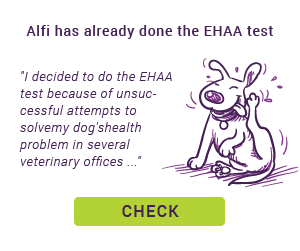Reproductive disorders don’t affect only people, but also animals. Dog breeders can face problems such as silent heat, dying embryos, small litters and miscarriage. In addition to genetics, the reasons can include incorrect diet. That’s why when establishing a breeding farm, you shouldn’t just focus on choosing the right animals and veterinary care, but a balanced diet as well.
PREPARING FOR BREEDING
A key role in preparing for breeding is the condition of both the male and female. It’s determined based on a five-point assessment (BCS – Body Condition Score), in which we distinguish between visual and palpation evaluation. Each number represents a different condition: 1 – emaciated, 2 – thin, 3 – ideal, 4 – overweight, 5 – obese. Before the animal is bred, it should be brought to optimal body weight and condition (a BCS of 3). Its ribs should be easily felt, there should be abdominal tuck, and the waist should be visible. Obesity in the male can hinder it from jumping and mating with the female, while emaciation is detrimental to semen quality. For bitches, excess fat can result in silent heat (the bitch doesn’t show signs of heat), disturbances of the sexual cycle, difficult labour (weaker uterine contractions) and lower lactation efficiency. Malnutrition is equally dangerous. It contributes to difficulties in fertilisation, more frequent embryo resorption, lack of ovulation, as well as lower birth weight of puppies and, as a result, increased puppy mortality.
In the mating period, nutrient requirements don’t differ much from those during sexual respite. The animal doesn’t need any extra protein in its food, but it’s good to use protein that’s high quality and has good biological value. For carnivorous animals, this is animal protein, which has a better amino acid composition and digestibility than vegetable protein.
One of the problems that dog breeders face is semen quality. Numerous studies have shown that this can be due to improper diet and deficiency in some nutrients. These include selenium – an element that plays a key role in spermatogenesis, which is the process of development and maturing of sperm. As an antioxidant, it sweeps up free radicals and protects sperm from the negative effects of active forms of oxygen. Selenium supplementation increases the concentration and volume of ejaculate, and reduces the frequency of sperm defects. It is recommended that selenium and vitamin E, which strengthens the activity of selenium, are used together. There are special products with both of these ingredients available on the market. Despite the beneficial effect of selenium and vitamin E on semen quality, don’t forget that an excess of these nutrients is harmful and can damage sperm.
The right quantity of minerals in the diet is equally important for bitches being prepared for breeding. Deficiencies in iodine, chromium and copper can lead to embryo death, while insufficient phosphorus can decrease the fertilisation rate by 50% and lead to silent heat. In addition, bitches whose meals did not meet their manganese needs were found to have delayed heat, pre-term labour and low postnatal body weight of puppies.
FEEDING A BITCH DURING PREGNANCY
 Pregnancy in bitches lasts approximately 63 days and is divided into three 21-day trimesters. A bitch’s nutritional needs don’t change before halfway through the second trimester (fourth to fifth week of the pregnancy). From the sixth week, the foetus starts growing rapidly, and so the bitch will need more building blocks for development, as well as energy. The food should be increased gradually so that her body mass increase doesn’t exceed 15-25% of the pre-pregnancy weight. Increasing the calorific value of meals helps create a reserve for the last week of the pregnancy, when the bitch will usually have low appetite.
Pregnancy in bitches lasts approximately 63 days and is divided into three 21-day trimesters. A bitch’s nutritional needs don’t change before halfway through the second trimester (fourth to fifth week of the pregnancy). From the sixth week, the foetus starts growing rapidly, and so the bitch will need more building blocks for development, as well as energy. The food should be increased gradually so that her body mass increase doesn’t exceed 15-25% of the pre-pregnancy weight. Increasing the calorific value of meals helps create a reserve for the last week of the pregnancy, when the bitch will usually have low appetite.
Protein in dog food, similar to that in the period of preparation for breeding, should have high biological value and digestibility of over 80%. Good-quality protein contributes to lower mortality of newborn pups and correct puppy post-natal body weight. According to FEDIAF feeding norms, requirements for this ingredient are, on average, 25g/100g dry matter. It should be remembered that protein content in a meal should be properly balanced compared with carbohydrates. This is related to the fact that during the breeding period, glucose is the main source of energy needed for foetal development. If you decide to implement a low- or no-carbohydrate diet, you’ll need to provide an alternative source of glucose, which is protein. By properly increasing the amount of protein in meals, you’ll provide the animal with glucogenic amino acids, which will then be used to make glucose. This is very important, as a deficiency of this simple sugar can lead to increased frequency of miscarriage and lower post-natal body weight of pups.
When feeding a pregnant bitch, don’t forget to give her the right amount of micro- and macroelements. This particularly applies to calcium and its ratio to phosphorus. From the fifth week of the pregnancy, the requirement for these elements increases significantly due to the rapid growth and mineralisation of the foetal skeleton. This is why when deciding to feed the dog homemade food, don’t forget about the right supplementation of these minerals. A deficiency of calcium, particularly in bitches of small breeds with many litters, can lead to puerperal tetany. Symptoms include twitching muscles, excessive salivation, fever and panting.
In the last weeks of pregnancy, bitches also have a higher need for iron, because it’s stored in the livers of the foetuses during this period. This is how newborn pups are protected against iron deficiency while being fed exclusively their mother’s milk, which is low in this element.
FEEDING NURSING DOGS
The lactation period for bitches is five to eight weeks. During this period, the breeder must not only meet the bitch’s vital needs, but also provide all nutrients necessary for milk production. The food should be high in calories (4-5 kcal/g dry matter), and have increased protein and fat. The most important mineral in this period is calcium, which is an ingredient in the bitch’s milk. At the peak of lactation, the requirement for this element can increase even fivefold, and this depends on the size of the litter. It’s recommended for calcium content in food to be at 250‑500 mg/kg body weight, and for the ratio of calcium to phosphorus to be 1.3:1.
SUMMARY
A well-balanced diet is a crucial element during the breeding period of dogs. It helps limit problems with fertility, and has a positive impact on the size and health of the litter. In addition to protein, fat and carbohydrates, minerals should also be taken into consideration, particularly calcium and phosphorus. These two elements are extremely important during pregnancy and lactation, and so it’s crucial to control their content in the bitch’s body, for example, by performing an EHAA.
Eng. Zootechnician, Katarzyna Żmuda

1.Alonge S., Melandri M., Leoci R., Lacalandra G. M., Caira M., Aiudi G. G. 2019. The Effect of Dietary Supplementation of Vitamin E, Selenium, Zinc, Folic Acid, and N-3 Polyunsaturated Fatty Acids on Sperm Motility and Membrane Properties in Dogs. Animals, nr 9(34)
2.Ceregrzyn M., Barszczewska B., Lechowski R. 2019. Podstawy żywienia psów i kotów. Wydawnictwo Edra Urban & Partner. Wrocław.
3.Domosławska A., Zduńczyk S., Franczyk M., Kankofer M., Janowski T. 2018. Selenium and vitamin E supplementation enhances the antioxidant status of spermatozoa and improves semen quality in male dogs with lowered fertility. International Journal of Andrology, nr 50.
4.Domosławska A., Zduńczyk S., Janowski T. 2019. Improvement of sperm motility within one month under selenium and vitamin E supplementation in four infertile dogs with low selenium status. Journal of Veterinary Research, nr 63, s. 293-297.
5.Domosławska A., Zduńczyk S., Niżański W., Jurczak A., Janowski T. 2015. Effect of selenium and vitamin E supplementation on semen quality in dogs with lowered fertility. Bulletin of the Veterinary Institute in Pulawy, nr 59, s. 85-90
6.Giziński S., Faundez R., Karska D. 2015. Postępowanie w przypadkach obniżonej jakości nasienia psów. Magazyn Weterynaryjny, nr 01.
7.Kanafa S., Kurosad A., Jurka P. 2015. Żywienie psów w okresie reprodukcji (krycia i ciąży). Weterynaria w Praktyce, nr 6, s. 88-91.
8.Mirowski A. 2012. Selen w żywieniu psów i kotów. Magazyn Weterynaryjny, nr 12.
9.Mirowski A. 2013. Wpływ żywienia na rozród psów. Magazyn Weterynaryjny, nr 09.
10.Woszczyło M., Pieczewska B. 2019. Jak karmić sukę w okresie ciąży i laktacji. Animal Expert, nr 11.












